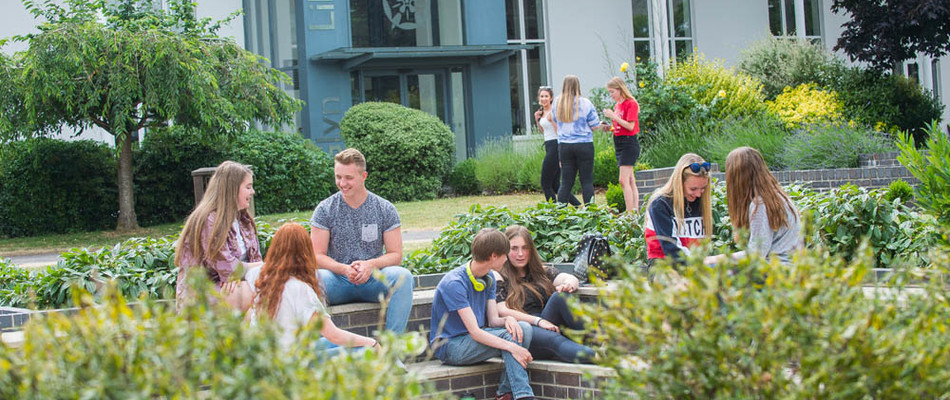Sixth form colleges, social justice (and saying thank you)
Back
This is a slightly shortened version of Sir Chris's address at the SFCA Winter Conference on February 7th, 2024.
When I was invited to speak at the SFCA Winter Conference, the most important thing I wanted to make sure to say was thank you – because I went to a sixth form college. Educationally it was the making of me.
I had a miserable time at a boys’ grammar school in the 1970s. I wasn’t good enough at rugby, and I spent most of my time being as inconspicuous as possible to avoid bullying attention – from both pupils and teachers. But around me the world seemed to be changing. 11-plus selection was being phased out – a political consensus shared across both Labour and Conservative local government, and the selective system in Nuneaton was replaced by a comprehensive system in 1974 at the instigation of Margaret Thatcher, who approved more comprehensive re-organisations than any other secretary of state. The boys’ grammar school I was at became a sixth form college and I moved into it in 1975.
The transformation was immediate. Uniforms disappeared, and with them went caps, prefects and detention. Stuffy traditions disappeared. Teaching styles changed. Girls arrived. There was a peer group interested in ideas and teachers encouraging us to question them. What combination of those things made the difference for me is for someone else to work out, but this inconspicuous and anonymous secondary pupil became confident and interested, and, consequently, did well academically.
In fact, of course, my story is a familiar one. Both of my grandmothers were in domestic service. My dad’s mum went into service from the workhouse, where she’d been sent with her brother as orphans. My wife did some work on family history and dug out this fact. When I said to my dad that I hadn’t realised that his mum had been in the workhouse, he said he hadn’t either – she simply wouldn’t talk about her childhood. Both my grandmothers had five children. My dad’s father, who had served in the army in India, re-enlisted at the start of the first world war. He was wounded on the Western Front and the only job he could hold down after the war was as a timekeeper in a weaving factory. My mum’s dad worked as a coal miner for forty-two years.
My mum and dad met when they both worked in the same weaving factory. My dad worked for 28 years in that factory before being made redundant in the industrial collapse which followed the oil price crash in the 1970s, after which he was made redundant four more times. He was enormously skilled, and he ended his career in a curious job which he loved. The War Pensions Board employed a team of home craft instructors, whose job was to drive round to war pensioners helping them to develop any home craft that were interested in. For the last decade of his working life, he was something between a personal tutor, a social worker and a conversationalist, and my mum took to accompanying him on travels across the Midlands, meeting remarkable people – often multiply disabled veterans undertaking thoughtful arts and crafts.
My experience was different. Unlike my granddads and dad, I didn’t leave school at 12 or 14. After my sixth form college, I went to Cambridge, where I got a starred first-class degree and went on to do a PhD. I met my wife at university. I had an early career as a secondary school teacher before moving into higher education. I became a university professor. I ran the Institute of Education, a world-leading research university and then Sheffield Hallam, one of the UK’s largest and most diverse universities. My academic specialism is in education policy, and I’ve worked all over the world. It’s been a career and a life my parents and grandparents could not even have dreamt of.
There’s a point to this potted version of Who Do You Think You Are? Remarkable though it would have seemed to my grandparents, my experience was not unusual in the later twentieth century. It was a time of social mobility, of the move from an industrial to a service economy. It is a story of the power of education and of the welfare state: unlike my parents and my grandparents, I benefited from free secondary education (introduced in 1944), family allowance (1946), free universal healthcare (1948) and free higher education (tuition and maintenance grants were introduced in 1961). I lived on the edge of a big council estate, built in 1953 as part of post-war reconstruction.
Mine is a story about a society in which individual success happens, where educational and social arrangements release the potential of young people to go as far as their attainment, aspirations and ambition can take them. Because of my own experience, I think sixth form colleges are a key plank in that egalitarian vision of education and in social mobility. In academic terms, social mobility is the link between a person’s occupation or income and the occupation or income of their parents. Where that link is strong, social mobility is low. Where it is weak, social mobility is high.
Instinctively, we want that link to be weak, and we want education to be one of the things which weakens it. We want people to have the same chances to do well in life regardless of their parental background, gender, age, sexual orientation, race, birthplace and so on. We want to live in a fair society.
But when we dig a bit deeper, we find some puzzles in the social mobility story. The first puzzle is that social mobility is something we can only see with hindsight, after it has happened. That means that our understanding is always out of date. The second puzzle is that when we talk about social mobility, we don’t actually all mean the same thing. We have different – and powerful - pictures in our heads. Broadly speaking we tend to have one of four different images in our heads about social mobility.
 The first image is about ‘levelling the playing field’– that’s a phrase which crops up in government policy documents. What comes to mind is a bumpy, uneven slope. Accidents of birth mean that some people start life further up the slope. Government can try to level the playing field so that ‘everyone has an equal chance to succeed’. It’s an approach which produces policies like universal early years provision, or funding for catch-up classes. But of course the playing field is never levelled, and it turns out to be a playing field studded with mole hills, so that keeping it a vestige of level is an endless game of ‘whackamole’ because the already advantaged try to maintain their advantages. In the UK only about one in six pupils eligible for free school meals go to university, compared to three quarters of those attending private school. There’s American research comparing the money spent on out of school activities by the poorest fifth and richest fifth of American families. In
The first image is about ‘levelling the playing field’– that’s a phrase which crops up in government policy documents. What comes to mind is a bumpy, uneven slope. Accidents of birth mean that some people start life further up the slope. Government can try to level the playing field so that ‘everyone has an equal chance to succeed’. It’s an approach which produces policies like universal early years provision, or funding for catch-up classes. But of course the playing field is never levelled, and it turns out to be a playing field studded with mole hills, so that keeping it a vestige of level is an endless game of ‘whackamole’ because the already advantaged try to maintain their advantages. In the UK only about one in six pupils eligible for free school meals go to university, compared to three quarters of those attending private school. There’s American research comparing the money spent on out of school activities by the poorest fifth and richest fifth of American families. In  1970, the richest fifth spent about twice as much as the poorest fifth on things like summer camps, music lessons and private tutoring. By 2010, the richest fifth were spending five times as much as the poorest fifth. There they were, as we all do, throwing up molehills. We pay for piano or violin lessons for our children partly because we adore hearing the classics massacred, but we also suspect it will stand them in good stead later in life.
1970, the richest fifth spent about twice as much as the poorest fifth on things like summer camps, music lessons and private tutoring. By 2010, the richest fifth were spending five times as much as the poorest fifth. There they were, as we all do, throwing up molehills. We pay for piano or violin lessons for our children partly because we adore hearing the classics massacred, but we also suspect it will stand them in good stead later in life.
The second image of social mobility is of a great glass elevator, whooshing a small number of the bright but poor from the bottom to the top. It’s the ‘room at the top approach’, focused on the make-up of the elite – the senior civil service, the judiciary. It’s the world of the meritocracy – government and society run by the most academically able. It’s the approach which produced grammar schools, accessed through an 11+ examination. It focuses on scholarship schemes at highly selective institutions. It involves talent spotting. I’ve obviously reason to be grateful to the approach, but it has obvious problems. Not all talents are visible early on, and some visible early talents disappear. And, of course, the elevator will never be big enough to accommodate all who should be in it.
 There’s a third picture of social mobility. This is the image of that Penrose spiral staircase, endlessly rising. This is the image of a more open society, in which everyone can steadily advance. It was a common view in the 1940s and 1950s, before inequality deepened after the 1970s oil price crash. Living standards were rising for almost all. This view led to the growth of comprehensive education, pioneered, though it is often forgotten not just in urban Labour councils but in rural Conservative ones, creating, in Harold Wilson’s phrase ‘grammar schools for all’. It led to the first wave of university expansion in the 1960s, and the ‘plate glass’ universities of Sussex, East Anglia, Kent, York and so on. It led to the idea of ‘parity of esteem’ widening opportunities for all. If it was attractive in the 1960s, that’s because the sense was of an open society with increasing opportunities. But that Penrose staircase is, after all, an optical illusion. That open society was a moment in time – and successive economic crises have left it in tatters. In the early 1960s, a school leaver with no qualifications could get a job well paid enough to pay for a house and a car. That’s no longer true.
There’s a third picture of social mobility. This is the image of that Penrose spiral staircase, endlessly rising. This is the image of a more open society, in which everyone can steadily advance. It was a common view in the 1940s and 1950s, before inequality deepened after the 1970s oil price crash. Living standards were rising for almost all. This view led to the growth of comprehensive education, pioneered, though it is often forgotten not just in urban Labour councils but in rural Conservative ones, creating, in Harold Wilson’s phrase ‘grammar schools for all’. It led to the first wave of university expansion in the 1960s, and the ‘plate glass’ universities of Sussex, East Anglia, Kent, York and so on. It led to the idea of ‘parity of esteem’ widening opportunities for all. If it was attractive in the 1960s, that’s because the sense was of an open society with increasing opportunities. But that Penrose staircase is, after all, an optical illusion. That open society was a moment in time – and successive economic crises have left it in tatters. In the early 1960s, a school leaver with no qualifications could get a job well paid enough to pay for a house and a car. That’s no longer true.
 And there’s a fourth picture of social mobility, which is the snakes and ladders board. In this picture, individuals can fall as well as rise. Social mobility is relative. The snakes and ladders analogy makes mobility an individual thing: you rise, by making the right choices in education, career or life, and – obviously – you slide down a snake if you make bad choices. In an open society with widening opportunities, there will be more ladders than snakes. But with weak economic growth, there will be as many losers as winners, or, more troublingly for politicians and for families, losers will outnumber winners. Relative social mobility is a mixed blessing. None of us want our children to be worse off than us.
And there’s a fourth picture of social mobility, which is the snakes and ladders board. In this picture, individuals can fall as well as rise. Social mobility is relative. The snakes and ladders analogy makes mobility an individual thing: you rise, by making the right choices in education, career or life, and – obviously – you slide down a snake if you make bad choices. In an open society with widening opportunities, there will be more ladders than snakes. But with weak economic growth, there will be as many losers as winners, or, more troublingly for politicians and for families, losers will outnumber winners. Relative social mobility is a mixed blessing. None of us want our children to be worse off than us.
Playing fields, elevators, optical illusions and snakes and ladders games are all different takes on social mobility. If society finds it hard to distribute opportunity fairly, it’s partly because we have such different ideas about what social mobility is. And that may be why thoughtful Conservative as well as Labour ministers wonder whether ‘social justice’ might be a better term. A minister in the current Conservative government said to me recently that he didn’t really like the term ‘social mobility’ – he preferred to talk about ‘social justice’. It’s not fair, for example, that across Europe children with the greatest economic disadvantage grow up to earn on average a fifth less than those with favourable childhoods.
But when it comes to agreeing on measures to make a difference, we fall between the elevator and the playing field, the board game and the optical illusion. And we are looking at all this in the rear-view mirror, at a society and economy which is disappearing from view.
There’s no easy solution to the challenge of social mobility. I was a baby boomer, born in 1959. I didn’t know it at the time – we never do – but I was lucky. I was unbelievably lucky. I threw a double six in the great game of world history. I was born in a rich society which was more open and more equitable than at any time in history, in a world becoming richer on peace, cheap oil and technical advances. In fact, we can pinpoint the moment of maximum equity in British history with absolute precision. It was at 8 pm on Christmas Day, 1977. It was the exact moment of maximum economic and cultural equality. 28 million people sat down to watch the Morecambe and Wise Christmas show: a national, shared cultural experience. Between 1945 and 1976, British society had become more equal economically and culturally. After 1977, inequality began to grow. Income mobility was a reality for people born between 1950 and 1970 but it stagnated for those born after 1970. I didn't know how lucky I was. None of us did.
So what does social mobility look like in the twenty-first century world of exponential technological change, of artificial intelligence, of resource depletion? There’s no golden bullet, but experiences around the world tell us that there are four things which make a difference in education. Obviously, these don’t all relate to the world of sixth form colleges but we will come to that a bit later.
- Children from poorer families start with unequal resources. Investing in education makes a difference. Investing in early years matters, but it’s not enough to give children a good start. Ensuring that public education is good quality for all is vital, and improving information, advice and guidance about career opportunities really matters.
- Investing in higher education expands choices. Of course, I would say this – I ran a university. There’s a continuing, and frankly very English debate about the size of higher education. For all Tony Blair’s 50% target for university attendance, the figure for progression to university at 18 is now about 42%. For comparison, that’s about the same as Australia and Germany, but the figure is 55% in the USA, and 75% in South Korea – the world’s most advanced economy. Higher education participation in China took a very sharp upward turn in about 1998, and is now north of 47%. There is a major research project called the Millennium Cohort Study, managed out of the Institute of Education, which I used to run. It tracks the lives of 19,000 children born in the year 2000. In 2007, their mums were asked what they wanted for their children in education. Almost nine out of ten wanted their children to go to university.
- Lifelong learning can mitigate the effects of poor early decisions. Employer investment in continued education and skills really matters: UK employers spend about half what German employers spend on training.
- Making a difference requires joined up strategies. Initiatives to support people during life transitions helps promote mobility and reduce the risks of falling into poverty. Strategic investments can increase productivity in regions, cities and other areas that lag behind: there is greater social mobility where there is less geographic inequality. Access to good quality, affordable housing and transport, and improved urban planning help reduce regional divides and concentrations of disadvantaged households in cities.
None of this is radical stuff: all those policy prescriptions are from the OECD and the IMF. No government can do all of them, but to make a difference, a mix of them is needed. It’s not easy. As the Guardian newspaper once put it, there’s just not enough fairness to go round.
The challenge of social justice in the twenty first century isn’t the challenge of social mobility in the middle of the twentieth century. The economy has changed. Society has changed. But the challenge is there. What we need is the shared commitment to make a difference and to understand the images others have about what success looks like now and for the future. We all know that you cannot navigate in the rear-view mirror.
So what are my takeaways. The 1970s is a very long time ago, and must seem very remote. Here’s my first: accessible, high quality and inclusive education is not a golden bullet but it makes a profound difference to individuals in the short and the long-term. None of us should ever forget that and we should all remember it as the core of our work every day. Education matters. Schools and colleges matter. Secondly, if one of the international weaknesses of English education is that we don’t, as many other advanced economies do, a clearly defined upper secondary education structure, it’s still the case that sixth form colleges are the nearest we’ve ever got to open, inclusive upper secondary education. We should hold onto that as a vision and a concept. Thirdly, when we talk about making a difference, about social mobility and social justice, we should remember that they are not straightforward ideas – those different images mean different things. If I’m right about my first two takeaways, you are in a powerful position to shape multiple ladders of opportunity whatever the policy and financial challenges. Fourthly, although effective institutions matter, the challenges we face in shaping a fairer, more inclusive society are beyond the skills and capabilities of any one of us. Institutional leadership is always about being an open-minded, generous partner and collaborator. We’ve undervalued the skills of collaborative leadership for too long. My own first book – twenty six years aho now – was called ‘Consorting and Collaborating in the Education Marketplace’, and I’ve never stopped believing in collaborative leadership or trying to practice it.
My final takeaway is a line I’ve quoted a lot. It’s from Charles Payne, who has fifty years experience of the American civil rights movement and whose book on education reform – So much reform, so little change – is still a powerful read sixteen years after it first appeared. Tucked away in that he has a formula for education and social justice which I’ve never bettered:
Give them teaching that is determined, energetic and engaging. Hold them to high standards. Expose them to as much as you can, most especially the arts.… Pay attention to their social and ethical development. Recognise the reality of race, poverty and other social barriers but make children understand that barriers don’t have to limit their lives … Above all, no matter where in the social structure children are coming from, act as if their possibilities are boundless. (Payne, 2008: 211-2).
Sir Chris Husbands has worked in higher education, public policy, strategic leadership and change management, and with governments, NGOs, think tanks and community groups, including as Vice-Chancellor of Sheffield Hallam University until December 2023 and Director of the Institute of Education at UCL from 2010-15.

